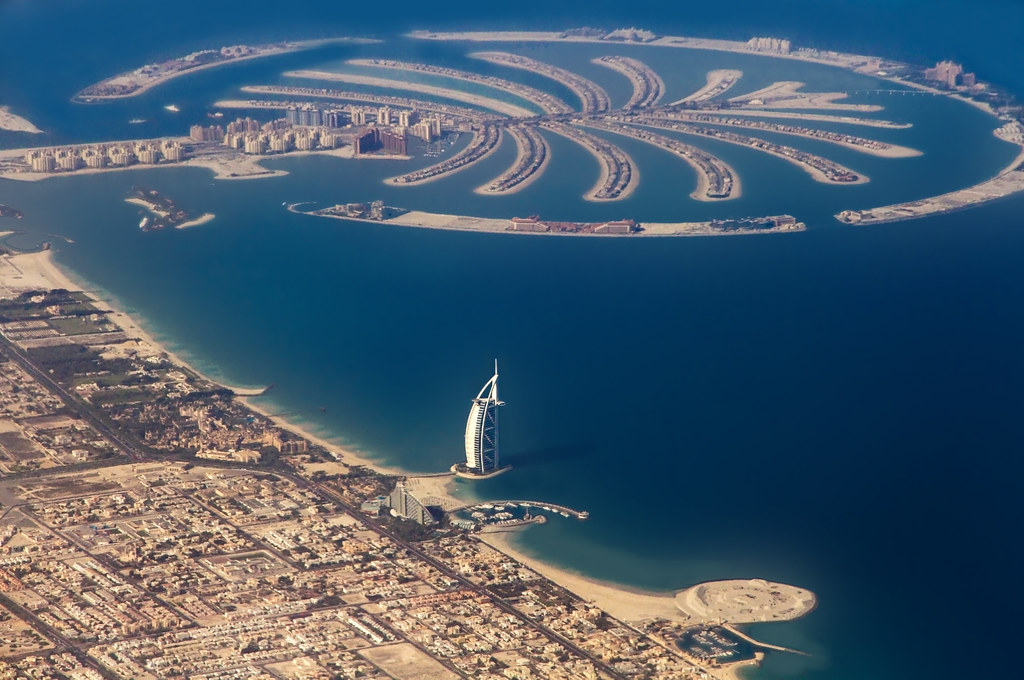Palm Jumeirah is a remarkable feat of engineering and a prime example of Dubai’s vision for creating luxury lifestyle destinations. Spanning 5.72 square kilometers, the island adds 78 kilometers of beachfront to Dubai’s coastline. It was constructed using land reclamation techniques, with millions of cubic meters of sand dredged from the sea bed, supported by breakwaters made from rock.
Design and Structure
The island is designed in the shape of a palm tree, with three main parts:
- The Trunk: The central part of the island, which connects to the mainland via a bridge. The trunk hosts apartment complexes, hotels, and retail outlets. It’s a hub of activity, with easy access to shops, restaurants, and entertainment.
- The Fronds: The 16 fronds are where the private, luxurious villas are located. These homes are some of the most exclusive in Dubai, offering residents privacy, beachfront access, and stunning views of the Arabian Gulf.
- The Crescent: The crescent acts as a protective breakwater, safeguarding the island from waves and sea erosion. It also hosts some of the most luxurious hotels and resorts, including the Atlantis The Palm, which is an attraction in itself.
Major Attractions and Facilities
- Atlantis, The Palm: One of the most recognizable landmarks on the island, Atlantis is a luxury hotel with an enormous water park, an aquarium, and several high-end restaurants. It’s a major draw for tourists and offers family-friendly activities.
- Nakheel Mall: Located at the center of Palm Jumeirah, this retail and entertainment hub features over 300 shops, a cinema, and a variety of dining options.
- The Pointe: This waterfront destination on the tip of Palm Jumeirah offers fine dining, shopping, and stunning views of the Atlantis. It is also home to the world’s largest fountain show, which draws visitors every night.
- Beach Clubs and Resorts: Palm Jumeirah is known for its beach clubs, such as Club Vista Mare, which offers seaside dining, and Five Palm Jumeirah, a popular hotel and beach club known for its lively atmosphere.
Accessibility
Palm Jumeirah is well connected to the rest of Dubai. Visitors can reach the island via car, using the Palm Jumeirah Road, or by using the Palm Monorail, which links the island to the mainland. The monorail offers stops at key points, including Nakheel Mall, Al Ittihad Park, and Atlantis, The Palm.
Real Estate and Living
Owning or renting property on Palm Jumeirah is highly sought after. The villas on the fronds are among the most prestigious properties in Dubai, offering direct access to private beaches. The island’s apartments, particularly in luxury towers along the trunk, also provide stunning views of the sea, marina, and skyline. Palm Jumeirah is considered an ideal location for high-net-worth individuals who desire a luxurious and serene lifestyle while being close to Dubai’s urban core.
Environmental Impact
While Palm Jumeirah is a marvel of human ingenuity, its construction has had environmental consequences. The land reclamation process disrupted marine ecosystems and altered coastal currents. Efforts have been made to restore the environmental balance through coral reef restoration and other measures.
Global Icon
Palm Jumeirah has established itself as a symbol of Dubai’s success and ambition. It’s a prominent tourist destination, drawing visitors from across the globe who are eager to experience its luxury lifestyle, world-class dining, and entertainment options. For investors, it remains a prime location for real estate and business opportunity.
For more details about visit and tour package contact Team Halal Tourism

